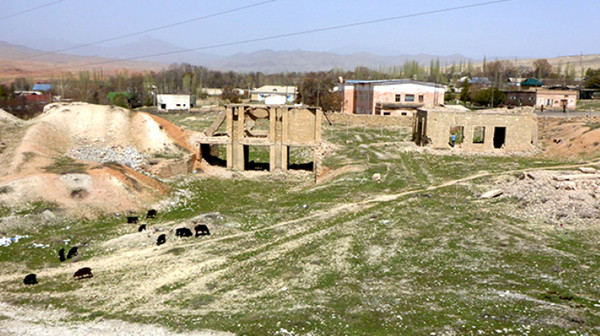Remediation work begins at Kyrgyz legacy uranium site
Work has started in Kyrgyzstan to overcome the legacy of uranium mining in Central Asia with a ground-breaking ceremony in Shekaftar, the European Bank for Reconstruction and Development (EBRD) announced on July 28. The Shekaftar mining complex includes three closed mines and eight mining-waste disposal areas that contain about 700,000 cubic metres of waste from mining operations.

The Shekaftar site in Kyrgyzstan (Image: EBRD)
Central Asia served as an important source for uranium in the former Soviet Union. Uranium was mined for over 50 years and uranium ore was also imported from other countries for processing. A large amount of radioactively contaminated material was placed in mining waste dumps and tailing sites. Most of the mines were closed by 1995 but very little remediation was done before or after the closure of the mining and milling operations. The contaminated material is a threat to the environment and the health of the population. The hazards include the possible pollution of ground and surface water in a key agricultural centre of the region.
At Shekaftar, near the border with Uzbekistan, dumps of waste rock, which is radioactive, are located around the village and next to a school, posing a risk to public health. Once a thriving community based on uranium mining, today the town has an unemployment rate of 70%, the EBRD noted.
"Despite the global disruptions caused by the coronavirus pandemic, intense project preparations continued in recent months to deliver the start of the construction works on schedule," the EBRD said. The first remediation works at Shekaftar will focus on the closure of six shafts and the relocation of five waste-rock dumps to an existing dump at a more remote location.
The work is funded by the Environmental Remediation Account for Central Asia (ERA), established and managed by the EBRD on behalf of the international donor community. Work on other sites in Kyrgyzstan is expected to begin soon. It will follow a Strategic Master Plan developed by a group of experts under the guidance of the International Atomic Energy Agency. The plan sets out a detailed blueprint for the environmental remediation of priority sites in the Kyrgyzstan, Tajikistan and Uzbekistan.
These three countries are currently in the scope of ERA, the latest nuclear decommissioning fund managed by the EBRD. To date, ERA has received support through contributions from the European Commission, Belgium, Switzerland, the USA, Norway and Lithuania.
Researched and written by World Nuclear News
- China Institute of Atomic Energy
- Nuclear Power Institute of China
- Southwestern Institute of Physics
- China Nuclear Power Operation Technology Corporation, Ltd.
- China Nuclear Power Engineering Co., Ltd.
- China Institute for Radiation Protection
- Beijing Research Institute of Uranium Geology (BRIUG)
- China Institute of Nuclear Industry Strategy (CINIS)
- China Nuclear Mining Science and Technology Corporation


